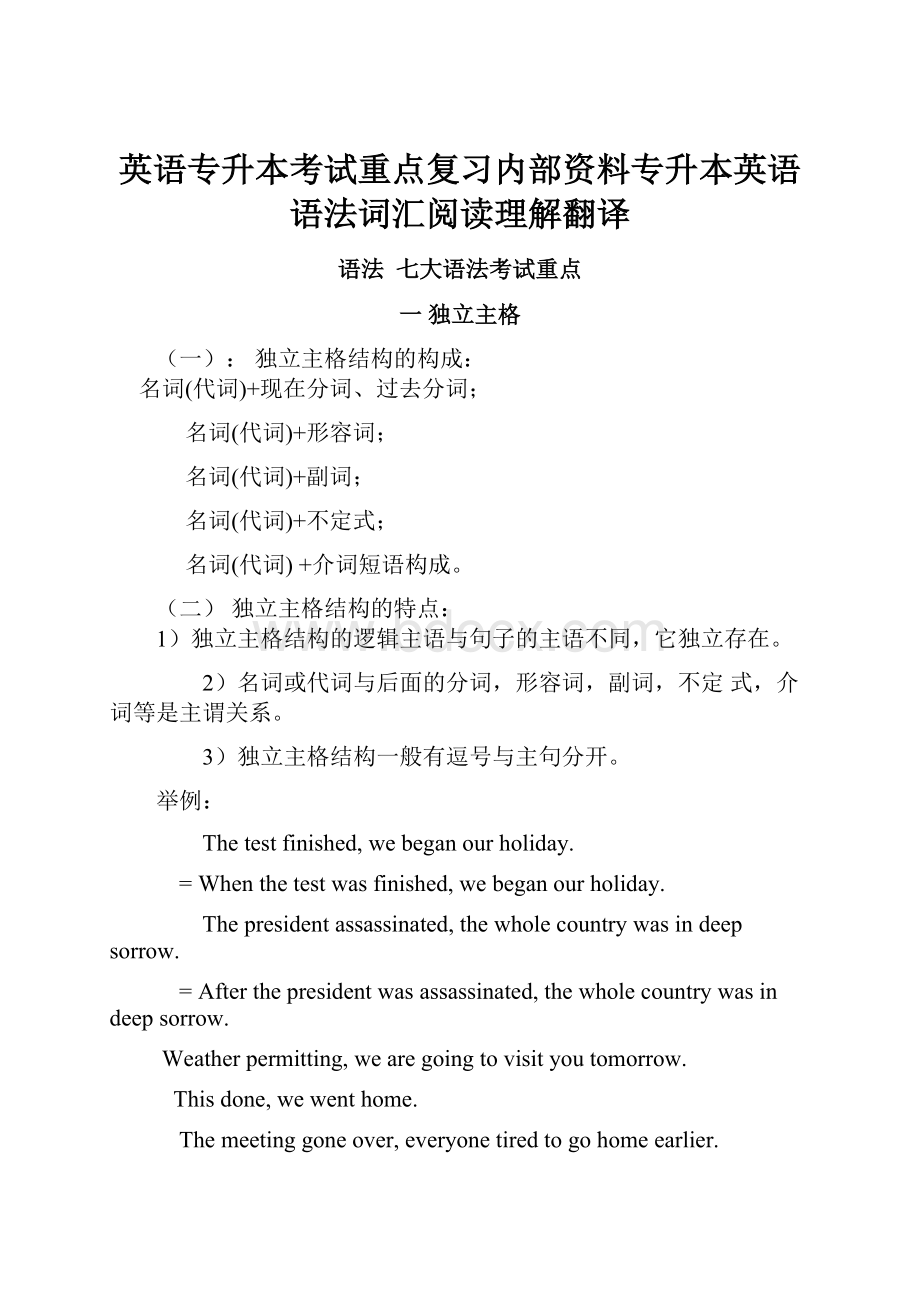 英语专升本考试重点复习内部资料专升本英语语法词汇阅读理解翻译文档格式.docx
英语专升本考试重点复习内部资料专升本英语语法词汇阅读理解翻译文档格式.docx
- 文档编号:22428962
- 上传时间:2023-02-04
- 格式:DOCX
- 页数:33
- 大小:39.52KB
英语专升本考试重点复习内部资料专升本英语语法词汇阅读理解翻译文档格式.docx
《英语专升本考试重点复习内部资料专升本英语语法词汇阅读理解翻译文档格式.docx》由会员分享,可在线阅读,更多相关《英语专升本考试重点复习内部资料专升本英语语法词汇阅读理解翻译文档格式.docx(33页珍藏版)》请在冰豆网上搜索。

Thisdone,wewenthome.
Themeetinggoneover,everyonetiredtogohomeearlier.
Hecameintotheroom,hisearsredwithcold.
Hecameoutofthelibrary,alargebookunderhisarm.
二过去完成时
1)概念:
表示过去的过去其构成是had+过去分词构成。
2)用法
a. 在told,said,knew,heard,thought等动词后的宾语从句。
Shesaid(that)shehadneverbeentoParis.
b.状语从句
在过去不同时间发生的两个动作中,发生在先,用过去完成时;
发生在后,用一般过去时。
Whenthepolicearrived,thethieveshadrunaway.
c.表示意向的动词,如hope,wish,expect,think,intend,mean,suppose等,用过去完成时表示"
原本…,未能…"
Wehadhopedthatyouwouldcome,butyoudidnt.
3) 过去完成时的时间状语before,by,until,when,after,once,assoonas。
HesaidthathehadlearnedsomeEnglishbefore.
Bythetimehewastwelve,Edisonhadbegantomakealivingbyhimself.
Tomwasdisappointedthatmostoftheguestshadleftwhenhearrivedattheparty.
典型例题
Thestudents___busilywhenMissBrownwenttogetabookshe___intheoffice.
A.hadwritten,left B,werewriting,hasleft C.hadwritten,hadleft D.werewriting,hadleft
注意:
hadnosooner…than 刚……就……
Hehadnosoonerboughtthecarthanhesoldit.
三强调结构
考试重点:
强调句型的基本形式Itis(was)+被强调部分+that(who)…;
强调句型用来强调状语。
一、强调句型的基本形式Itis(was)+被强调部分+that(who)…。
二、强调句型用来强调状语。
1、Itwasinthatsmallroom_____theyworkedhardanddreamedofbetterdaystocome.
A.where B.inwhich C.which d.that
2、Itisbecausesheisverydevotedtoherstudents_______sheisrespectedbythem.
A.that B.which C.what D.who
3、Itwasnotuntilshearrivedinclass_________realizedshehadforgottenherbook.
A.andshe B.when C.she D.thatshe
四情态动词
情态动词+完成时
情态动词用来表示能力、允许、许诺、可能、劝告、意愿等概念或态度。
情态动词无人称变化,在句子中和动词原形一起构成谓语。
根据这几年的考试看,着重测验情态动词接完成时的用法。
一、must+现在完成时 表示对已发生的事情的一种肯定的猜测。
1、Mr.Green_____myletter,otherwisehewouldhaverepliedbeforenow.
A.musthavereceived B.musthavefailedtoreceive C.mustreceive D.mustfailtoreceive
2、Ibelievehe_____anaccident,otherwisehewouldhavearrivedontime.
A.wouldhavehad B.couldhavehad
C.shouldhavehad D.musthavehad
二、should(oughtto)+完成时 表示应该做的事情而没有做,否定式表示不该做的事情做了。
含有对过去的动作的责备、批评。
1、Theyhavedonethingstheyought_____.
A.nottodo B.nottobedone C.nottohavedone D.nothavingdone
2、I’msorryIcouldn’tgetintouchwithhimbeforeheleft,I_____himearlier.
A.hadatelephone B.havephoned C.shouldhavephoned D.shouldbephoned
三、could+完成时 表示能做的事情而没有做。
表示对过去能做而未做的事情感到惋惜,遗憾。
1、Hecouldhavejoinedus,buthedidn’tgetourinvitationintime.
2、Icouldhavepassed,butIdidnotstudyhardenough.
五虚拟语气
虚拟语气的基本形式和用法;
if的省略形式;
含蓄条件句;
以wish(that)引导的表示“愿望”的宾语从句;
wouldrather引导的从句;
以asif,asthough引导的从句;
以suggest,advise,insist等词后引导的宾语从句;
Itisnecessary(important)that引导的主语从句;
Itistime(that)…句型中。
一、虚拟语气的基本形式和用法:
虚拟(条件)语气中,主句与从句中谓语动词的形式可分为下面三类:
1、IwouldaskGeorgetolendusthemoneyifI_____him.
A.hadknown B.haveknown C.knew D.know
2、Doyouthinktherewouldbelessconflictintheworldifallpeople_____thesamelanguage?
A.spoke B.speak C.hadspoken D.willspeak
3、IfBob____withus,hewouldhavehadagoodtime.
A.wouldcome B.wouldhavecome C.hadcome D.came
二、if的省略形式
在虚拟条件句中,如谓语包含were,had,should等词,则可以把这些词放到主语前面,省略if。
1、_____youwerebusy,Iwouldnthavebotheredyouwithmyquestions.
A.IfIrealized B.HadIrealized
C.DidIhaverealizedthat D.AsIrealized
2、_____,Ishouldaskthemsomequestions.
A.Shouldtheycometous B.Iftheycometous C.Weretheycometous D.Hadtheycometous
三、含蓄条件句
有时一个假设的情况不用条件从句表示,而用其它方式来表示,这样的句子叫含蓄条件句。
常用with,without,butfor。
1、Withoutyourhelp,we_____somuch.
A.didn’tachieve B.wouldnothaveachieved C.willnotachieve D.don’tachieve
2、Butfortherain,we_____aniceholiday.
A.shouldhave B.wouldhavehad C.wouldhave D.willhavehad
四、以wish(that)引导的表示“愿望”的宾语从句
wish后的宾语从句中要用虚拟语气,而在虚拟语气中时态的应用类似在非真实条件中从句时态的应用。
表示现在或将来的愿望用:
主语+wish+从句(主语+过去时);
表示一个过去没有实现的愿望用:
主语+wish+从句(主语+过去完成时);
1、Peterwishesthathe_____lawinsteadofliteraturewhenhewasincollege.
A.couldstudy B.studied C.hadstudied D.wouldstudy
Ididn’tgototheparty,butIdowishI_____there.
A.were B.wouldbe C.hadbeen D.willbe
五、wouldrather+句子(过去时)
1、I’d_____youdidn’ttouchthat,ifyoudon’tmind.
A.rather B.better C.happier D.further
Iamtoobusythesedays.Iwouldratherallofyou_____nextmonthforadinner.
A.come B.wouldcome C.came D.havecome
六、以asif,asthough引导的从句
在asif,asthough引导的从句中,如果谈论的是不可能或不真实的情况时,它们所引用的状语从句要用虚拟语气,动词形式和wish后面的从中动词形式变化相同。
1、Hetalksasifhe_____everythingintheworld.
A.knows B.knew C.hadknown D.wouldhaveknown
2、Youaretalkingasifyouhadseenthem
七、以suggest,advise,insist等词后引导的宾语从句中,从句的谓语动词要用should+动词原形,should可以省略。
类似的动词有:
propose,order,demand,require,request等。
1、ThedoctoradvisedthatMr.Malan_____anoperationrightawaysoastosavehislife.
A.had B.wouldhave C.have D.wasgoingtohave
2、Hismotherinsistedthathe_____thecoatwhengoingout.
A.puton B.putson C.toput D.puttingon
八、Itisnecessary/important/urgentthat引导的主语从句中,从句的谓语动词要用should+原形动词,should可以省略。
1、It’sdesiredthatshe_____toteachusatleasttwiceaweek.
A.comes B.willcome C.come D.maycome
2、It’surgentthatameeting_____beforethefinaldecisionismade.
A.willbearranged B.mustbearranged
C.bearranged D.wouldbearranged
九、Itistime(that)…引导的定语从句中,谓语动词用过去时。
1、It’shightimewe_____somethingtostoptrafficaccident.
A.do B.willdo C.did D.mustdo
2、Don’tyouthinkitistimeyou_____smoking?
A.giveup B.gaveup C.wouldgiveup D.shouldgiveup
六状语从句
在主从句中起状语作用的从句叫状语从句。
常见的状语从句有时间、地点、条件、原因、让步、方式、比较、目的、结果。
一、时间状语从句
常用的连词有:
when,whenever(无论什么时候),since,as,until,hardly…when,nosooner…than,assoonas,before,after,themoment,theminute(一…就…)
1、Nosoonerhadtheygotthegoodscoveredup_____itstartedraininghard.
A.when B.than C.then D.after
2、Shehaswantedtobecomeanurse_____sinceshewasayounggirl.
A.long B.often C.always D.ever
二、条件状语从句
常用if,unless(除非,如果不),as/solongas只要。
1、_____I’mmistaken,I’veseenthatmanbefore.
A.Unless B.If C.Because D.Provided
2、_____youreturnthosebookstothelibraryimmediatelyyouwillhavetopayafine.
A.Until B.Unless C.If D.Provided
三、原因状语从句
常用:
because,as,since。
如果表示必然的因果关系,一般用because引入;
而since表示一种间接或附带的原因;
用as只是提一下。
1、Hecannotgotoschoolbecauseheisill.
2、Everyonelikesyouasyouarebothkindandhonest.
四、让步状语从句
常用though/although,as(尽管),evenif/though,however,whatever,wherever,whoever,nomatterhow/what/who等
1、Inshort,_____helives,amanbelongstosomesociety.
A.whatever B.whenever C.whichever D.wherever
2、_____,youmustshowyourtickettogointothecinema.
A.Nomatterwhoeveryouare B.Whomeveryouare
C.Whoeveryouare D.Nomatterwhoareyou
3、_____youdisagreewithher,herideaisstillworthconsidering.
A.Evenif B.Ifonly C.Insteadof D.Despiteof
4、Young_____heis,heknowswhatistherightthingtodo.
A.that B.as C.although D.however
五、方式状语从句
常用as,justas,asif/though等词。
1、_____waspointedabove,thissubstancecanbeusedasasubstitute.
A.It B.That C.What D.As
2、Hetalksasifhe_____everythingintheworld.
A.knows B.knew C.hadknown D.wouldhaveknown
六、目的状语从句
常用sothat,inorderthat,lest(以免,以防),incase。
1、Iwroteitdown_____Ishouldforgetit.
A.incase B.incaseof C.inorderthat D.forfearof
2、I’llgiveyoumyphonenumber,sothatyoucancallmewhenyouarrivehere.
七、结果状语从句
常用so…that,such…that
Theyare_____studentsthattheyallperformedwellinthenationwideexaminations.
A.sodiligent B.suchdiligent C.somuchdiligent D.suchverydiligent
七主谓一致
形式上复数、意义单数的名词做主语;
动名词、不定式,从句做主语;
anumber+of+复数名词和thenumber+of+可数或不可数名词做主语;
主语由aswellas等词修饰时的主谓一致;
当用and连接的名词前有each,every等修饰时,谓语动词用单数。
一、名词physics(物理),maths(数学),news(新闻),means(方法),works(工厂)等一般被认为是形式是复数,意思是单数的名词,它们做主语的时候动词一般用单数形式。
Everymeanshasbeentried.
二、动名词、不定式、从句做主语时,谓语动词用单数。
Whenandwherethenewhospitalwillbebuilt_____amystery.
A.toremain B.remains C.remain D.isremaining
三、当主语是anumber+of+复数名词时,谓语动词用复数;
当主语是thenumber+of+可数或不可数名词时,谓语动词用单数
1、Anumberofcars_____infrontofmyhouse.
A.wasparked B.wereparking C.isparking D.areparked
四、当主语由aswellas等词修饰时的主谓一致。
当句中的主语后接aswellas,alongwith,togetherwith,including,accompaniedby等短语+名词(代词)时,主语与谓语的一致关系不受影响,主语是单数名词时,谓语动词用单数形式,主语是复数形式时,谓语动词用复数。
1、John,alongwithtwentyfriends,isplanningaparty.
2、NoonebutJaneandTomwastherethen.
五、当用and连接的名词前有each,every等修饰时,谓语动词用单数。
当主语是each…and…,every…andevery…,manya…and…结构时,谓语动词用单数。
1、Manyasingeranddanceristoattendoureveningparty.
2、Inourcountryeveryboyandeverygirlhastherighttorecei
- 配套讲稿:
如PPT文件的首页显示word图标,表示该PPT已包含配套word讲稿。双击word图标可打开word文档。
- 特殊限制:
部分文档作品中含有的国旗、国徽等图片,仅作为作品整体效果示例展示,禁止商用。设计者仅对作品中独创性部分享有著作权。
- 关 键 词:
- 英语 考试 重点 复习 内部 资料 英语语法 词汇 阅读 理解 翻译
 冰豆网所有资源均是用户自行上传分享,仅供网友学习交流,未经上传用户书面授权,请勿作他用。
冰豆网所有资源均是用户自行上传分享,仅供网友学习交流,未经上传用户书面授权,请勿作他用。


 《Java程序设计》考试大纲及样题试行.docx
《Java程序设计》考试大纲及样题试行.docx
